 |
Tewkesbury Abbey |
 |
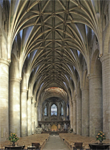 |
| Further details on
the Abbey's
website. This is a particularly excellent website and the
church welcomes and provides first class facilities for
visitors. Entry is free but the church respectfully asks for
donations for upkeep. I paid a modest fee to take the
photographs but a site states that photography is 'restricted'
without clarifying what is meant by that. Tewkesbury was a Benedictine Abbey but became a parish church at the Dissolution. |
| The Nave |
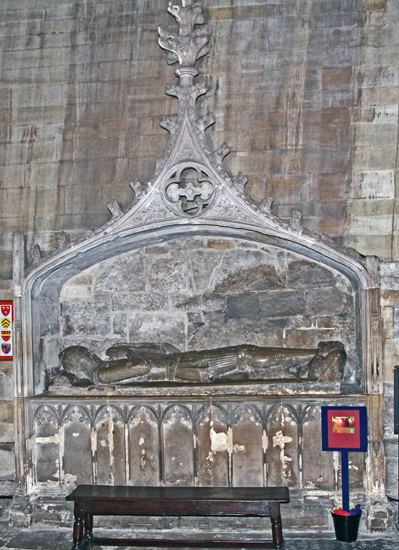 Above and centre top: Unknown mid 14th century knight under contemporary arch. An early example of the return of 'straight legs', after the 'crossed legs period' |
 |
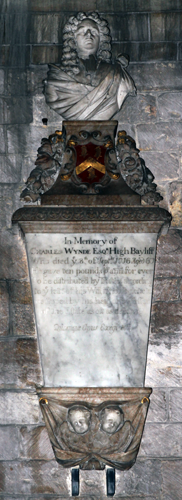 Above: Charles Wynde (1716) Marble |
||
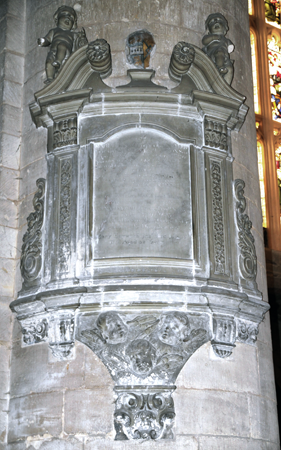 |
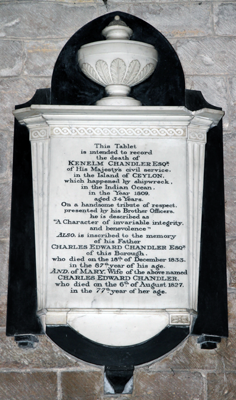 |
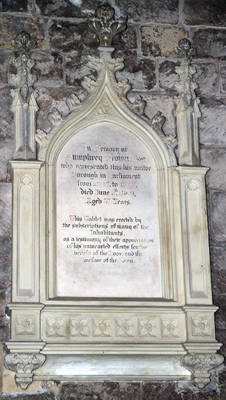 |
||
| Not legible, possibly Tayler | Kenhelm Chandler (1809) Neo-Greek marble tablet by Gardner of Tewkesbury 1833 | Humphrey Brown (1860) | ||
| South Choir Aisle |
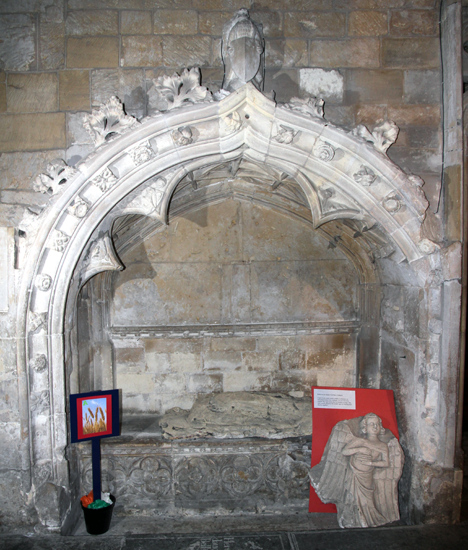 |
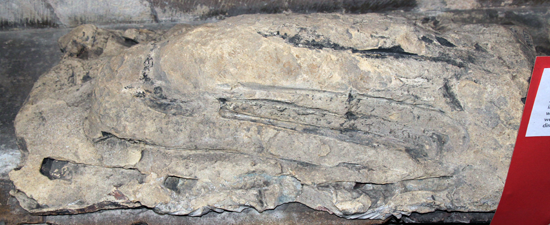 |
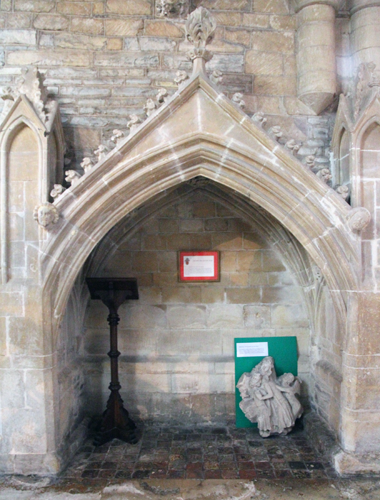 |
| Left & above: Tomb with
tomb chest and badly broken effigy. Right: Tomb with no chest or effigy. Below left & centre top:Abbot Alan (1202) the biographer of Thomas Becket. Purbeck marble top with foliated cross. Below right & centre bottom: Abbot Robert Forthington (1254) Purbeck marble coffin slab with small figure in low relief within the head of a foliated cross; ogee canopy. |
||
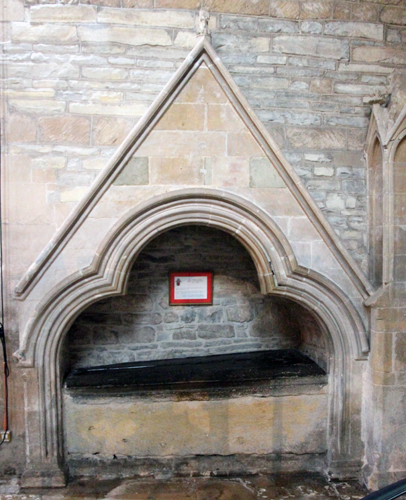 |
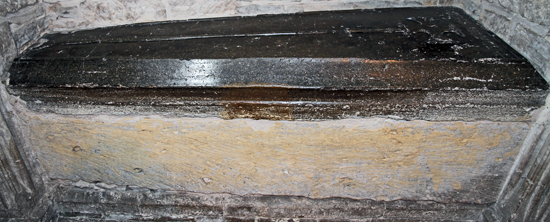 |
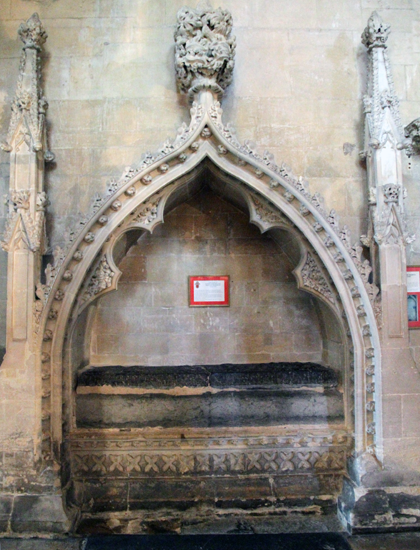 |
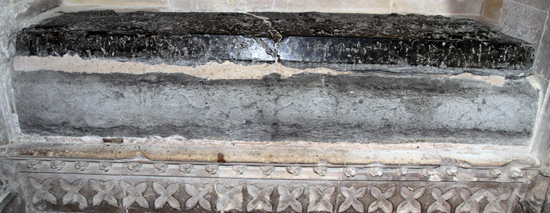 |
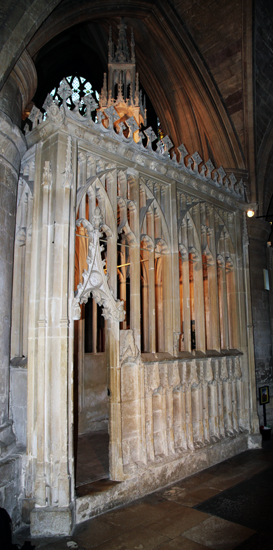 |
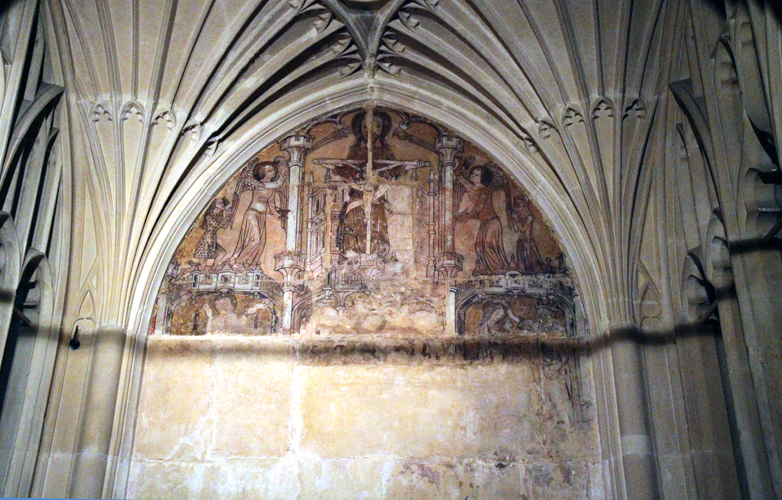 Edward 1st Baron Despenser (1375) Chantry chapel - or Trinity Chapel. On the left is the entrance to the chapel from the choir aisle while on the right that from the choir. The structure surmounting the chapel houses a kneeling figure of a knight (far right), a very unusual attitude in medieval monuments. Above is the interior of the chapel showing fan vaulting and wall painting. |
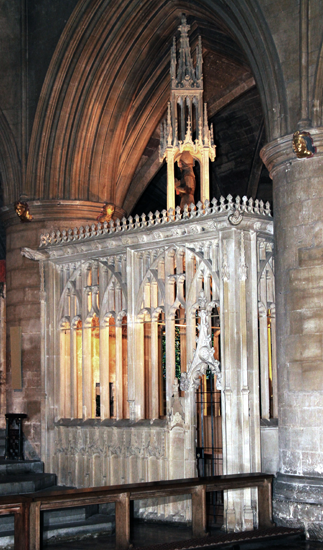 |
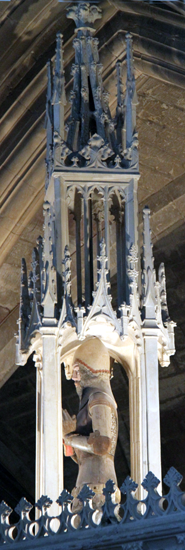 |
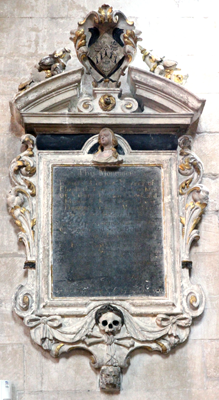 |
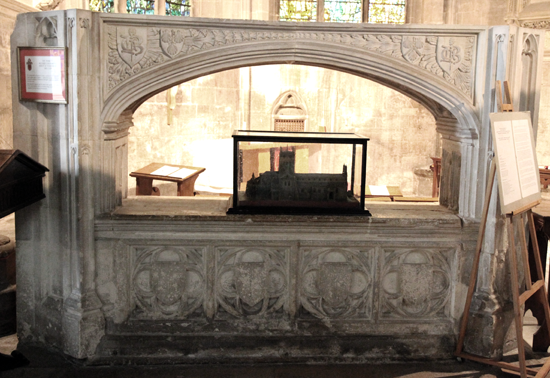 |
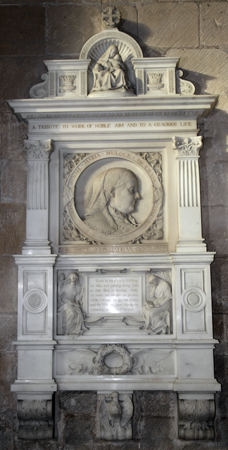 |
| Elizabeth Townsend Note the tiny bust above the inscription panel |
Abbot Cheltenham (Abbot 1481-1509) Note the canopy with shields, scallop shells and pilgrim's staves. |
Dinah Maria
Craik (Mullock) (1887) Writer |
| Ambulatory |
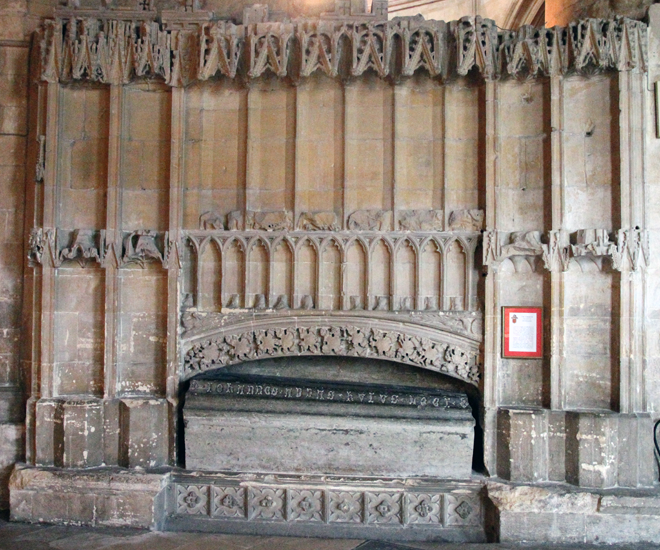 |
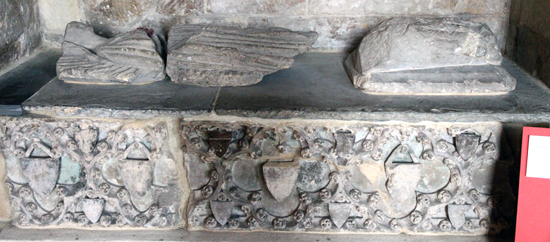 |
 |
 |
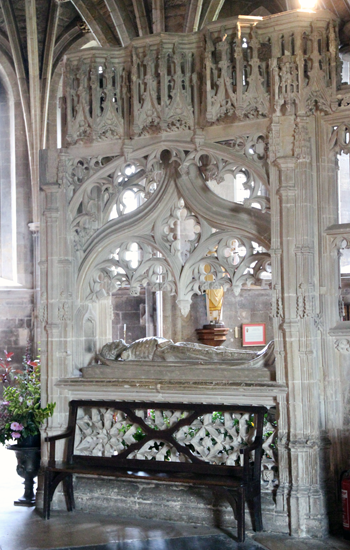 |
Above left and centre bottom:
Hugh Despenser (ex 1326). A much mutilated tomb as
the canopied niches used to contain many images. The coffin it contains is unrelated, being that of John Cotes (Abbot 1328-47). It is of Purbeck Marble and with a very clear inscription. Above right and centre top: Tomb of unknown person with mutilated effigy. These monuments are at the back of the sedilia. |
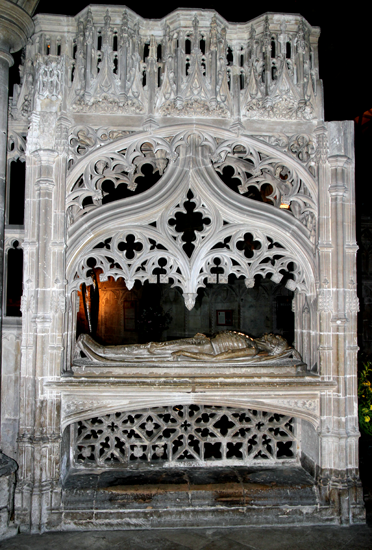 |
 |
||
| Above, left & right: 'Wakeham' Cenotaph' (mid 15th century: i.e. a century earlier than John Wakeham, the last Abbot who died in 1549). The cadaver is placed on the hollow altar tomb rather than, as is the usual practice, below with the living representation of the deceased shown in splendour above; it lies in a open shroud, crawling with vermin - a gruesome sight. The canopy is said to have been copied for the throne of the House of Lords. |
| North Choir Aisle |
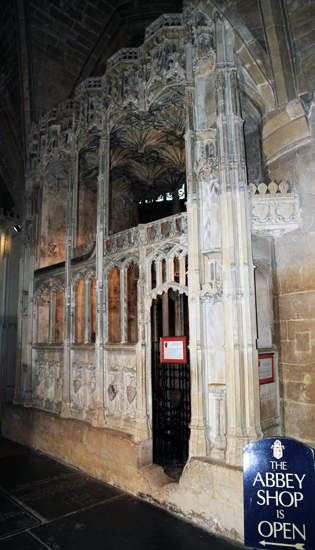 |
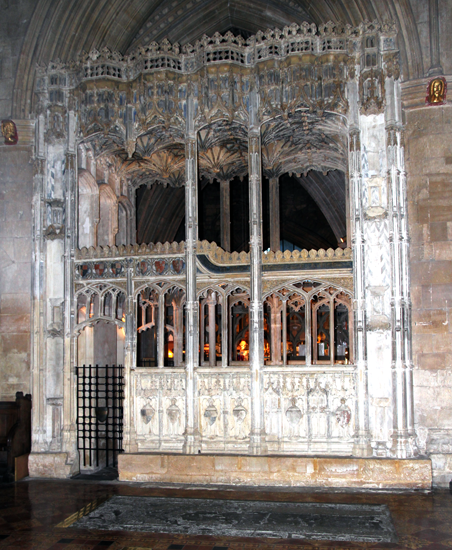 |
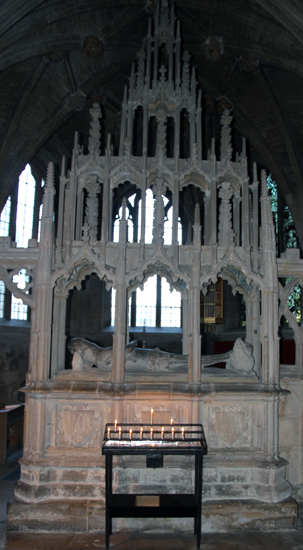 |
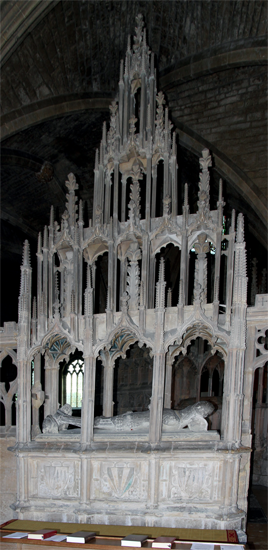 |
| The Beauchamp Chapel from the aisle and from the choir wasbuilt about 1430 by Isabel Despenser, Countess of Warwick as a chantry chapel for her first husband Richard Beauchamp , Earl of Worcester (1421). The chapel is of two storeys and the upper may once have contained the kneeling figures of Isabel and her two husbands. | Sir Guy de Brian (1390) He married the widowed Elizabeth Montaguein 1350. (see below). He was standard bearer to Edward III at Crécy. The canopy with remains of colouring and gilding. Above monument from the north choir aisle and St Margaret's Chapel. The effigy is shown below centre top. | ||
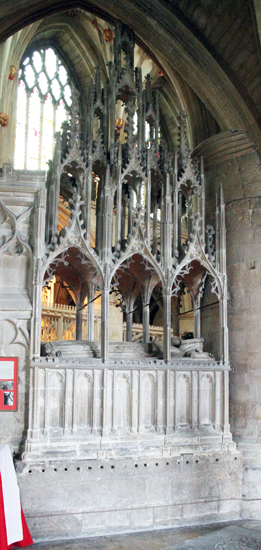 |
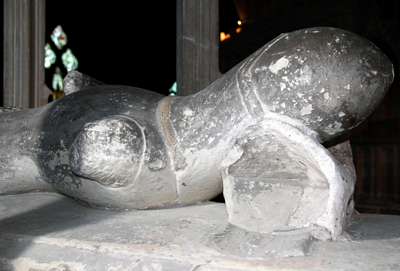 |
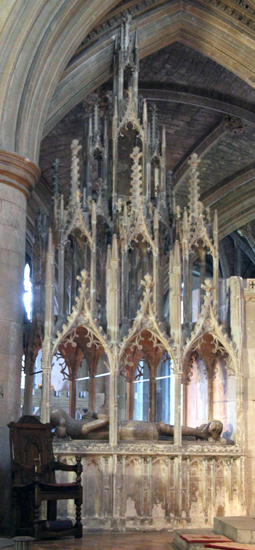 |
 |
||
| Top:
Effigy of Guy de Brian (see above) Left, above and right: Hugh, 3rd Baron Despenser (1348) and Elizabeth Montague (1359) Recumbent alabaster effigies. Very fine canopy. Below left: Laeitia Hale Below centre: Archdeacon Robeson (1912) Altar tomb with effigy by Bryan Baker. (see also below) Below right: Robert Eaton (1687) 'Pastor of this church' |
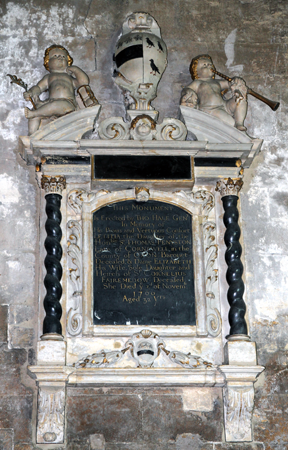 |
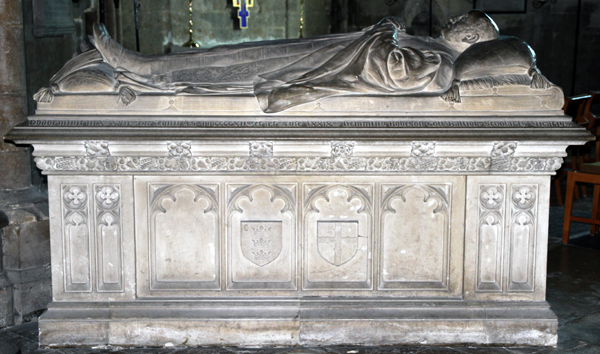 |
 |
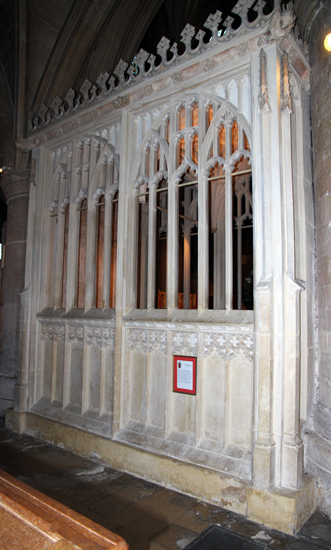 |
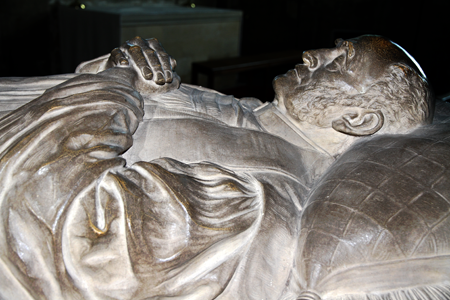 |
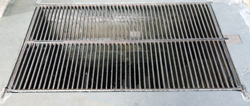 |
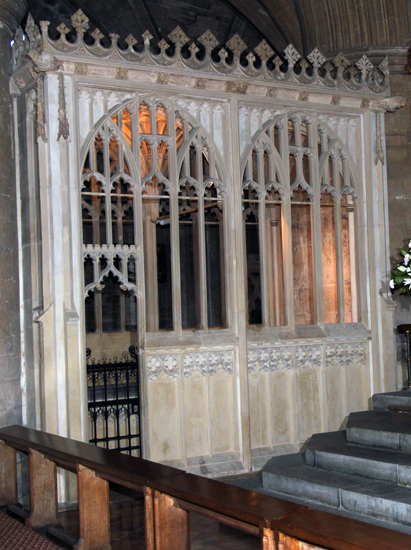 |
|
Left: Detail of the above
effigy Above: 'The Clarence Vault' entrance.This vault, behind the High Altar contains the bones of George, Duke of Clarence (1478) and his wife Isabelle Neville, now housed in a glass case. They were presumably contained in separate coffins. A slab with two brass may have originally laid over the vault. |
|||
 |
|||
|
Chantry Chapel of Robert Fitzhamon
(1107) He was the founder of the Abbey
though the chapel dates from about 1395. A very
fine example of the perpendicular.
Left:
'The Founder's Chantry' from the north
choir aisle Right: The same from the choir Above: Tomb chest in the Founder's Chantry, showing inlays for lost brasses. |
|||
| North Tansept |
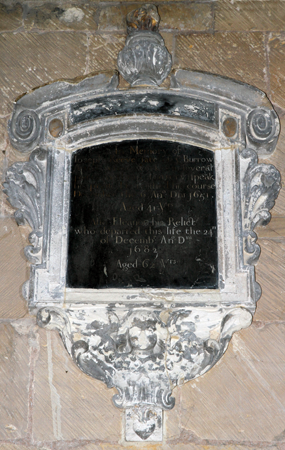 |
| Joseph Reeve (1651) artist, stone and slate Baroque tablet |
|
The Choir |
|||
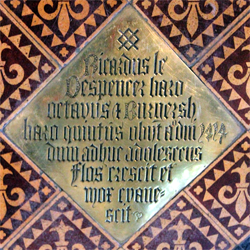 |
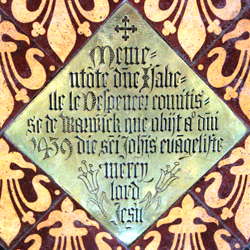 |
 |
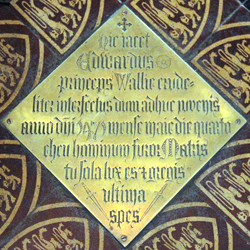 |
| Richard le Despenser (1414) | Isabel le Despenser (1439) |
Thomas le Despenser (ex .1400) Note the Axe |
Edward, Prince of Wales
(k. 1471) Note the swords |
| Please
note that the section on Tewkesbury Abbey is incomplete
and will be revised, completed and the photographs
replaced with more satisfactory ones in due course. The following monuments, described in Pevsner, have not yet been added: Dr George Peyton (1742) Classical marble tablet by Thomas White of Worcester. (ambulatory) John Roberts of Fiddington (1631) half length upright effigy (north transept) Thomas Collins (1900) builder; alabaster tablet with portrait in low relief. (south transept) Mann Family Classical marble tablet with cherubs heads and torches by Richard Squire of Worcester, 1749 (south transept) |
|
|
A Who's Who
of the
Burials in Tewksbury Abbey There are a number of tombs of medieval historical characters who were buried in Tewkesbury Abbey. This is a list with brief notes on the more well known from this period, which will hopefully clarify what can be rather confusing; for further details follow the links given above. It can be rather complicated because of the number of intermarriages that occured and the identical titles and even names of different people. |
|
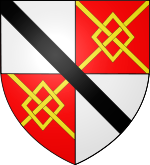
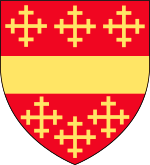
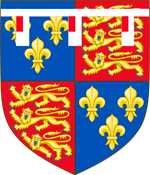 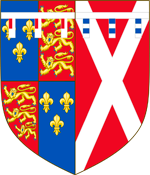 |
||
| Beauchamp, Richard de, 1st Earl of Worcester (c. 1394 - 1421) married Lady Isabelle le Despenser (q.v.); they had one child, a daughter Elizabeth. He was wounded at the Siege of Meaux and died shortly afterwards. This siege was part of the 100 Years' War under King Henry V and it is during this siege that the King became ill and died three months later aged 36. The town capitulated. Elizabeth inherited her father's estates and the Barony of Bergavenny although the earldom became extinct on his death. Bryan, Guy de, 1st Baron Bryan (c.1319 - 1399) Fought under Edward III in the Second Scottish War of Independence and the Hundred Years' Way, being active in the battles of Sluys and Crécy. He was the second husband of Elizabeth Montague Despenser, Edward le, 1st Baron Despenser (1375) went to France with the Black Prince and fought at the Battle of Poitiers. He was a friend and patron of Jean Froissart. He was succeeded by his son, Thomas who became Earl of Gloucester (see below) Despenser, Hugh le (c. 1286 - 1326) called 'The Younger Despenser' was the son of Hugh, Earl of Winchester, called 'The Elder Despenser'. He married Eleanor de Clare one of the three sisters of Gilbert de Clare, 4th Earl of Gloucester; the latter's death at the Battle of Bannockburn (1314) resulted in the three sisters becoming co-heiresses. He became a favourite of King Edward II and gained the hostility not only of the Queen, the barons but also the common people. He was captured by Roger Mortimer, the lover of Queen Isabella (Edward II's wife) and sentenced to be hanged, drawn and quartered by Mortimer and the Queen. In 1330 his widow, Eleanor, was given permission to bury his remains but only received his head, a femur and some vertebrae. In the 1970's at the site of Hulton Abbey in Staffordshire a skeleton was excavated with the very bones missing that Eleanor had received; furthermore the bones showed the signs the the body had been hanged, drawn and quartered. Radiocarbon dating in 1990 showed that the date of the skeleton was 1050 - 1385 and other examinations showed it to be of a male who had been more than 34 years old. Hugh the Younger died in 1326 art 40. It is thus highly likely that this was the rest of his skeleton. Incidentally his father, Hugh the Elder, suffered a more giriely fate from the Queen and Mortimer's justice: he was hanged, beheaded and his body cut to pieces and fed to the dogs. Despenser, Hugh le, 3rd Baron Despenser (c. 1308 - 1348) was the son of Hugh 'The Younger Despenser', above. Both his father and grandfather were executed by Mortimer and Isabella but this Hugh was imprisoned. He was released by King Edward III and restored to the barony. He married Elizabeth Montague, daughter of the Earl of Salisbury. Despenser, Isabelle le ( 1400 - 1439) was the young sister of Richard (d. 1414) and this daughter of Thomas le Despenser, 1st Earl of Gloucester (ex. 1400); she was born six months after the execution of her father. She married twice: 1. Richard de Beauchamp, 1st Earl of Worcester (1394 - 1422) who died at the siege of Meaux in the 100 Years' War ; 2. Richard de Beauchamp, 13th Earl of Warwick (1382 - 1439). (He is the Earl of Warwick with the magnificent bronze effigy in St Mary's, Warwick). This marriage produced two children: 1. Henry, 14th Earl of Warwick (1425 - 1446), who later became the 1st Duke of Warwick; 2. Anne, 16th Countess of Warwick, who had inherited the title after the death of her brother, the 14th Earl and the latter's daughter, the 15th Countess, who had died as a child. This Anne married Richard Neville, later to be known as the 'King Maker'. The two daughters of this marriage - Anne and Isobel - married respectively King Richard III (she had first been married to Prince Edward, son of King Henry VI) and George, Duke of Clarence, brother to Richard III and Edward IV. Dispenser, Thomas le, 1st Earl of Gloucester (1373 - 1400) . He was the father of Isabel above. He supported King Richard II against the Lords Appellant and was rewarded with the Earldom of Gloucester. However he later supported Henry Bolingbroke on his return to England, only to be attainted for his part in the murder of Thomas of Woodstock, Earl of Gloucester, uncle to King Richard and a leading Appellant. Henry Bolingbroke deposed King Richard and became king as Henry IV. Thomas took part in the Epiphany Rising, a rebellion of a number of barons aimed at assassinating King Henry and restoring Richard to the throne. This rising failed when the conspirators were betrayed by Edward, 2nd Duke of York; the conspirators took flight only to be captured and killed by an angry mob loyal to Henry. Thomas himself was captured and beheaded. Montague, Elizabeth (1359) was daughter of William, 1st Earl of Salibury. She married 1) Hugh 3rd Baron Despenser; 2) Guy de Bryan. Plantagenet, Edward, Prince of Wales (1453 - 1471) Known as 'Edward of Westminster', was the son of King Henry VI and Margaret of Anjou, born during the Wars of the Roses, the conflict between the House of Lancaster and the House of York, decendents of Edward III, for possession of the Englsih throne. In 1460 King Henry was captured at the Battle of Northampton by the Yorkists under the command of Edward, Earl of March (the future Edward IV) and Richard Neville, Earl of Warwick ('The Kingmaker'), Queen Margaret and her son, the seven year old Edward, fleeing to Cheshire. The Yorkist leader, Richard, 3rd Duke of York, was dissuaded from taking the throne there and then but he persuaded parliament to pass the Act of Accord, which allowed King Henry to reign during his lifetime, disinherited Edward, Prince of Wales and named the Duke of York as king on Henry's death. Queen Margaret and her son travelled to Scotland to raise support and gathered together a somewhat disorder army which marched into England and defeated the Yorkists at the Battle of Wakefield, where the Duke of York was killed. Margaret now marched south and defeated the Earl of Warwick at the Second Battle of St Albans. Warwick had left King Henry behind on the battle field guarded by two of his knights to see he came to no harm. They were captured by Queen Margaret who asked her son - now eight - what should be done with them: 'cut their heads off', was the young boy's reply. Margaret began to march on London but retreated. Plantagenet, George, Duke of Clarence (1449 - 1478 ) was the third of the four surviving sons of Richard, Duke of York and Cecily Neville and thus the next youngest brother of King Edward IV. He actively supported his brother's claim to the throne initially but when Richard Neville, Earl of Warwick (The 'Kingmaker') broke with Edward to join Margaret of Anjou and the Lancastrians, he joined them also, expecting a better reward than that from Edward. Warwick gave him his elder daughter Isobel in marriage and Henry VI made him his heir of his son, Prince Edward. Clarence soon realized that Warwick had no intension of promoting him further but rather was planning to restore Henry VI to the throne especially after his marrying his second daughter, Anne, to Prince Edward; Clarence began secret negotiations with Edward and was restored to favour. Warwick was killed at the Battle of Barnet and Prince Edward at the Battle of Tewksbury; Clarence became Earl of Warwick 'by the right of his wife' and Anne Neville, now the widow of Prince Edward, married King Edward's younger brother Richard, Earl of Gloucester, the future Richard III. Clarence caused further problems for his brother, who had now lost patience with his fickle and unstable brother, and was arrested for treason. He was sentenced to death and executed, it is said, by being drowned in a butt of Malmesbury wine. Wakeham, Abbot John was born as John Wiche. He was prior at the time of death of Abbot Henry Beeley, when a license was issued under the great seal for the election of a new abbot. It seems that John Wiche was then elected but under circumstances which were suspect because of his dealings with the government. At the dissolution he surrendered the abbey in 1539 and received a pension of 400 marks per annum. At this time he seemed to have taken the name of Wakeham. He was shortly consecrated the first Bishop of Gloucester, when he forfeited his pension, and was buried not in Tewkesbury but in this Cathedral. He is said to have built the monument we see today during his time as abbot although it is infact a century older than the time of his death. It is a cenotaph - an empty tomb - and although it is named after John Wakeham it is not known whom it commemorates. |